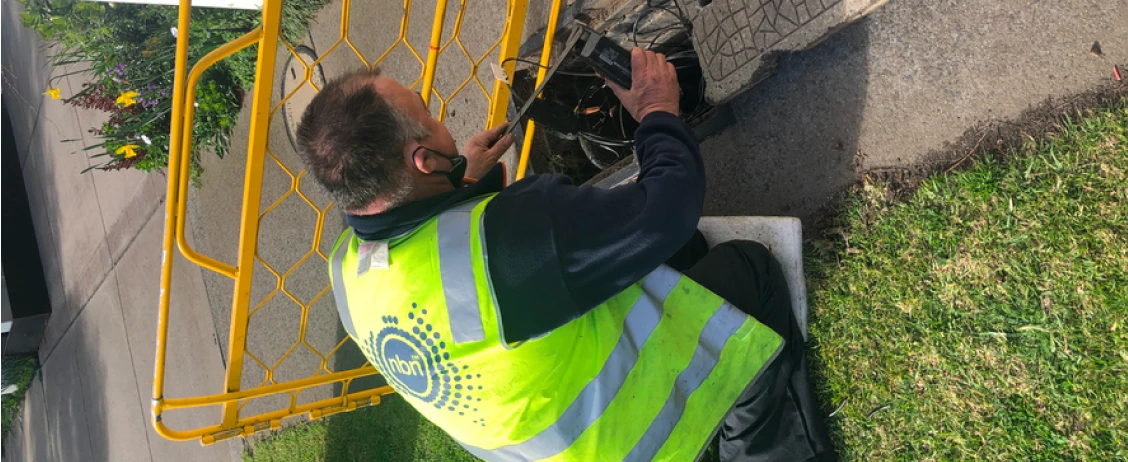Incompatible Devices - Emergency Calling (000) Update - more info here.
Things you need to know about nbn HFC
Learn about HFC technology, installation, and speeds.

The National Broadband Network (nbn) in Australia delivers high-speed internet using a mix of technologies, one of which is Hybrid Fibre Coaxial (HFC). This technology is primarily used in areas where existing pay TV cable networks were already in place, allowing for a relatively fast and cost-effective broadband rollout.
HFC combines the benefits of fibre optic and coaxial cable technology to deliver high-speed internet. Originally developed for cable television, HFC was later adapted for broadband use and has been widely implemented in telecommunications networks worldwide. In Australia, NBN Co has upgraded many existing HFC networks, incorporating advanced technologies to improve speed and reliability.
HFC plays a crucial role in the nbn Multi-Technology Mix (MTM), providing fast and stable internet to many urban and suburban areas. Unlike Fibre to the Node (FTTN), which relies on old copper telephone lines, HFC offers superior performance due to its use of coaxial cable, which supports higher bandwidth.
How HFC Works
Understanding HFC technology
HFC is called hybrid because it combines two different technologies: fibre optic cables for most of the network and coaxial cables for the final connection to homes and businesses. This setup allows for high-speed data transmission while leveraging the existing cable broadband infrastructure.
Fibre optic component
In HFC network, fibre optic cables carry internet data from NBN Co's central network to local distribution points known as nodes. Fibre optics offer extremely high speeds and low latency, making them ideal for long-distance data transmission.
Coaxial cable component
From the node, the internet signal is transmitted via coaxial cables to individual properties. Coaxial cables were originally used for pay TV services and are capable of handling high data speeds. While not as fast as fibre optic cables, they still provide significantly better performance than copper-based ADSL or FTTN connections.
DOCSIS technology
HFC networks use a technology called Data Over Cable Service Interface Specification (DOCSIS) to manage internet traffic. DOCSIS 3.0 and DOCSIS 3.1 are the two main versions currently in use. DOCSIS 3.1, which NBN Co is gradually rolling out, enables higher speeds, improved efficiency, and lower latency compared to its predecessor.
HFC Installation Process
Setting up HFC connection requires a few steps by you, but most of the process is handled by NBN Co and your chosen internet provider.
Pre-installation requirements
Before installation, you need to check whether your property has access to HFC or some other connection type. This is determined by nbn.
You can check this by entering your address on the address search found in the NBN Co website. If your home is eligible and not yet connected to the nbn – most homes are -, you’ll need to book an installation appointment through your ISP.
Step-by-Step installation guide
Technician Visit: An NBN technician will visit your property to assess the setup and install necessary equipment. You will be advised of any additional infrastructure costs that you are responsible for paying in order to proceed.
Installing the nbn connection box: The technician will set up an NBN Connection Box (NTD) inside your home, which acts as the main connection point for your modem/router. A self-install kit can also be provided, removing the need for a technician visit and fast-tracking the installation
Connecting the Coaxial Cable: If your property has an existing pay TV or cable broadband connection, the technician may use the same coaxial port. Otherwise, a new cable will be installed.
Testing the Connection: Once everything is in place, the technician will test the connection to ensure it's working correctly.
Activating the Service: You may need to set up your modem/router according to your ISP’s instructions before your service is fully activated.
Handling existing pay TV connections
If you previously had a cable service, your existing coaxial cable may be reused for NBN HFC. However, if you still use pay TV via cable, additional modifications may be required to avoid interference.
Performance
HFC provides some of the fastest speeds available on the NBN network, but actual performance can depend on various factors.
Available speed tiers
HFC supports multiple speed tiers, including:
nbn 25 (25 Mbps download, 5 Mbps upload) and NBN 50 (50 Mbps download, 20 Mbps upload) – Suitable for light internet usage.
nbn 100 (100 Mbps download, 20-40 Mbps upload) – Great for streaming, gaming, and most internet needs comfortably. (Typical Evening Speed 100/17Mbps)
nbn 250 (250 Mbps download, 25 Mbps upload) – Available in some HFC areas, best for large households.
nbn 500 (500 Mbps download, 50 Mbps upload) - Multiple devices, great for gaming, 4K streaming, and smart systems.
nbn 1000 (1 Gbps download, 50 Mbps upload) – The fastest option, though only available in select locations.
nbn 2000 (2 Gbps download, 100 Mbps upload) - Ultra-connected households with a wide range of smart devices
Factors affecting speed
Several factors can impact your HFC speed, including network congestion, modem/router location and quality, and DOCSIS technology version. Network congestion is particularly noticeable during peak hours when many users are online simultaneously.
Comparison with Other nbn technologies
Compared to FTTN and Fixed Wireless, nbn HFC speeds are generally more consistent. However, Fibre to the Premises (FTTP) still offers better long-term scalability and reliability.
Read Also: FTTP vs HFC Vs FTTN Vs FTTC
Benefits
HFC technology provides several advantages, making it a popular connection type for high-speed broadband users.
High speed capabilities
With DOCSIS 3.1, nbn HFC speed can reach gigabit levels, making it suitable for 4K streaming, online gaming, and smart home connectivity.
Widespread availability
HFC is available in many metropolitan and suburban areas, covering millions of Australian households. Since it utilises existing cable networks, deployment is faster compared to full fibre rollouts.
Potential for future upgrades
NBN Co is investing in network upgrades, including expanded DOCSIS 3.1 adoption, which will improve speeds and stability in the coming years.
Troubleshooting and Maintenance
Like all broadband connections, HFC can experience occasional issues.
Common issues and solutions
Check whether the coaxial cable is securely connected if your nbn HFC connection drops out. Restarting your modem and NTD can also help resolve connectivity issues.
Tips for optimal performance
Positioning your Wi-Fi router in a central location can improve signal strength. Using Ethernet connections for devices that require stable speeds, such as gaming consoles, can also enhance performance.
Read Also: How to improve your internet speed
When to contact your service provider
If you experience significant and frequent slow speeds or dropouts, contact your ISP’s customer support. In some cases, a technician visit may be necessary to replace faulty equipment or reconfigure the connection.
Future of HFC
Planned upgrades and improvements
NBN Co is continuing to enhance HFC technology, with DOCSIS 3.1 upgrades improving speed and network capacity. Future advancements may further reduce network congestion and allow for even faster speeds.
DOCSIS 3.1 and beyond
The rollout of DOCSIS 3.1 is a major step toward gigabit-speed broadband, bringing HFC performance closer to FTTP levels. With continued improvements, HFC will remain a strong broadband solution for many years.
HFC is a key part of Australia’s broadband infrastructure, offering high-speed internet to millions of homes. By combining fibre optic and coaxial cable technology, it provides a balance of speed, reliability, and affordability.
Understanding how HFC works, its installation process, and its potential for future upgrades can help users maximise their internet experience. With ongoing enhancements, HFC remains a valuable and future-proof broadband option for many Australian households.
Related Articles
© Copyright 2025 Exetel Pty Ltd. All rights reserved.


